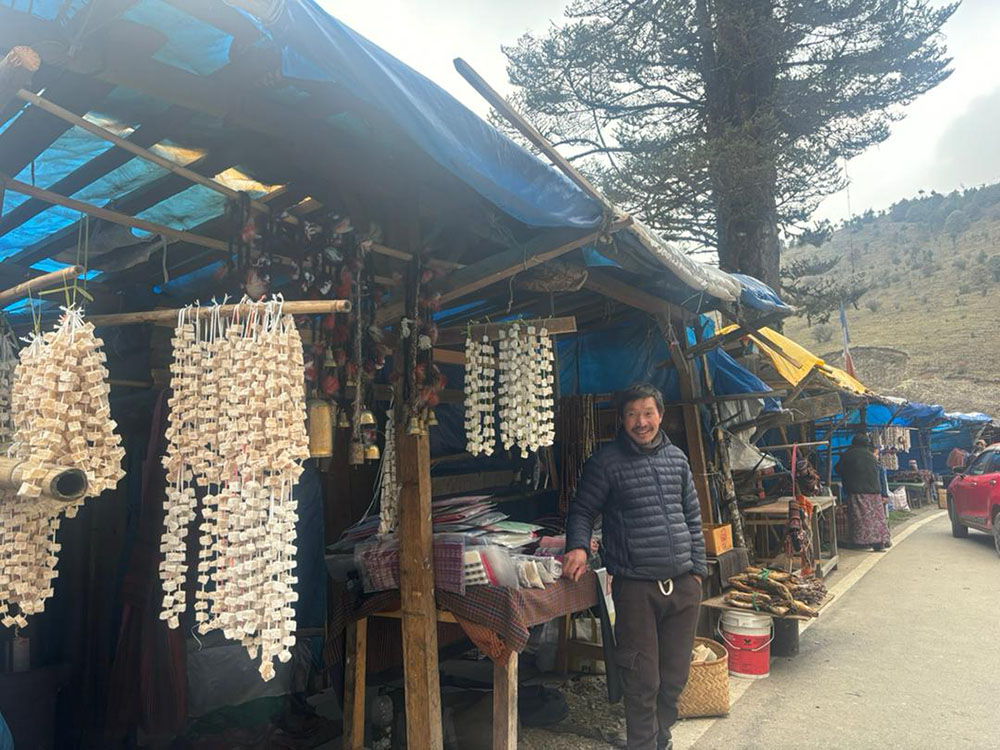Yangyel Lhaden
In one of Pelela’s simple shops, Kinzang Dorji has his most special clothes called ngosham and kira. They’re made from wool from nearby sheep and cost Nu 30,000. These clothes are some of the best things he sells. But every evening, he takes them home and puts them back in his shop the next day.
Kinzang says, “I can only sell the real local handicrafts of Bhutan once in a while.” Like other sellers, his top items are chugo and gho belts made from wool.
At the shops on the top of Pelela mountain, you can find handicrafts from Bhutan like yathra products, ropes, and slingshots made from yak wool, as well as bells and hangers also made from yak wool. They also sell yak meat and bamboo items. Additionally, there are goods from Nepal like shawls, earrings, and rosaries, along with locally dried vegetables and incense items.
One issue for Kinzang is that he can’t sell enough items made locally in Bhutan. But he’s even more concerned about two bigger problems: there are fewer yaks around, which means less yak wool for products, and fewer people are making bamboo items and other crafts.
Kinzang points at the bamboo products and says, “There are only five elderly individuals in Sephu Gewog who make these.” He then gestures towards the ngosham and explains, “This is made from local sheep wool. Sephu has altogether stopped raising sheep.”
Continuing, he says, “Even though I’d prefer to buy bells from local craftsmen, modernisation has led to blacksmiths no longer making them. That’s why I have to import them.”
He concludes with concern: “I fear that one day, it will become history that these kinds of local products were available in Bhutan.”
Another vendor, Yangden, who is 27 and from Sephu, says, “The yathra products we say are genuine are actually made from wool we bring in, which is a mix of yak wool and other artificial materials. If we burn it, plastic comes out.”
Yangden shows a bag made from Bhutanese yak wool in her store. They feel rough, tough, and prickly.
“Sometimes tourists ask us why we’re selling items from other countries, but we don’t have a choice. I have to admit, some of them are imported,” Yangden says.
She stressed the importance of the government requiring all items sold in handicraft shops to be sourced and made locally in Bhutan. This rule should be enforced by law to guarantee fair competition. When one seller starts selling imported goods, others feel pressured to do the same.
Yangden adds, “At least for clothes made from yak wool, even though the wool itself is imported, our local weavers from Bumthang weave it, keeping some authenticity. They’re skilled at creating any patterns needed. But the problem is, there just aren’t enough yaks or sheep to produce wool and support local wool products.”
The yak population in Bhutan has decreased significantly from 2007 to 2022. In 2007, there were 51,500 yaks in the country, but by 2022, this number had dropped to 20,328. Similarly, during this time, Wangdue’s yak population decreased from 2,913 in 2007 to 2,518 in 2022.
The sheep population has also been declining from 2007 to 2022, as per livestock statistics. In 2007, there were 12,415 sheep, with 1,680 of them in Wangdue. However, by 2022, the total sheep population decreased to about 10,000, with Wangdue having only about 700 sheep left.
Kinzang explains that because people in his region are making money from cordyceps, they’re choosing to stop raising livestock. Additionally, the younger generation isn’t as interested in raising yaks and sheep anymore.”I have to admit, I’m not interested in raising yaks either,” Yangden says. She mentions that her family’s around 200 yaks have been passed on to her uncle. Now, her cousin, who grew up in the mountains, takes care of them. “She’s used to the tough conditions and mountain life, so she can handle staying up there,” Yangden explains.
Kinzang so concludes: “Considering the dwindling supply of materials for local production and the younger generation losing interest in arts, crafts, and livestock rearing, doesn’t my prediction about local products becoming history seem more likely?”


